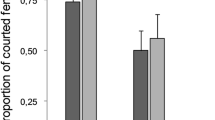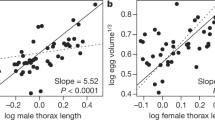Abstract
We used guppies to study repeatability in sperm competitiveness and postcopulatory sexual selection on male ornamentation. In a block design involving 25 pairs of males, artificial insemination was used to mate each pair (A and B) to four unrelated females—two that were mated with the combined ejaculates of both males (sperm-competition treatment) and two receiving sperm from each of the two males individually (single-male treatment). Our analysis revealed significantly repeatable patterns of paternity across females in the sperm-competition treatment, suggesting that certain males are intrinsically better sperm competitors than others, irrespective of female identity. Next, we compared mean brood success (number of offspring per brood) between sperm competition and single-male treatments. We found no significant effect of treatment on female fecundity, suggesting that the previously reported direct benefits of polyandry in this species may be due to factors such as differential maternal effects or differences in the number of inseminated sperm between treatments. Our artificial insemination assay was designed to control both factors. Finally, we determined whether variation in relative paternity was random with respect to male phenotype. Unlike previous work on Trinidadian populations, we found no significant relationship between male sexual ornamentation and sperm competitiveness in the focal population.

Similar content being viewed by others
References
Andersson M (1994) Sexual Selection. Princeton University Press, Princeton, NJ
Andersson M, Simmons LW (2006) Sexual selection and mate choice. Trends Ecol Evol 21:296–302
Arnqvist G, Danielsson I (1999) Copulatory behavior, genital morphology, and male fertilization success in water striders. Evolution 53:147–156
Bangham J, Chapman T, Partridge L (2002) Effects of body size, accessory gland and testis size on pre-and postcopulatory success in Drosophila melanogaster. Anim Behav 64:915–921
Becher SA, Magurran AE (2004) Multiple mating and reproductive skew in Trinidadian guppies. Proc R Soc Lond B 271:1009–1014
Becher SA, Russell ST, Magurran AE (2002) Isolation and characterization of polymorphic microsatellites in the Trinidadian guppy (Poecilia reticulata). Mol Ecol Notes 2:456–458
Billard R (1969) La sperm spermatogenese de Poecilia reticulata. Ann. Biol. Anim. Bioch. Biophys. 9:251–271
Birkhead TR, Pizzari T (2002) Postcopulatory sexual selection. Nat Rev Genet 3:262–273
Blount JD, Møller AP, Houston DC (2001) Antioxidants, showy males and sperm quality. Ecol Lett 4:393–396
Boorman E, Parker GA (1976) Sperm (ejaculate) competition in Drosophila melanogaster and the reproductive value of females to males in relation to female age and mating status. Ecol Entomol 1:145–155
Brooks R, Endler JA (2001) Female guppies agree to differ: phenotypic and genetic variation in mate—choice behavior and the consequences for sexual selection. Evolution 55:1644–1655
Cunningham EJA, Russell AF (2000) Egg investment is influenced by male attractiveness in the mallard. Nature 404:74–77
Danielsson I (2001) Antagonistic pre-and post-copulatory sexual selection on male body size in a water strider (Gerris lacustris). Proc R Soc Lond B 268:77–81
Evans JP, Magurran AE (2000) Multiple benefits of multiple mating in guppies. Proc Natl Acad Sci USA 97:10074–10076
Evans JP, Magurran AE (2001) Patterns of sperm precedence and predictors of paternity in the Trinidadian guppy. Proc R Soc Lond B 268:719–724
Evans JP, Simmons LW (2007) The genetic basis of traits regulating sperm competition and polyandry: can selection favour the evolution of good-and sexy-sperm? Genetica, In press
Evans JP, Zane L, Francescato S, Pilastro A (2003) Directional postcopulatory sexual selection revealed by artificial insemination. Nature 421:360–363
Froman DP, Pizzari T, Feltmann AJ, Castillo-Juarez H, Birkhead TR (2002) Sperm mobility: mechanisms of fertilizing efficiency, genetic variation and phenotypic relationship with male status in the domestic fowl, Gallus gallus domesticus. Proc R Soc Lond B 269:607–612
Gil D, Graves J, Hazon N, Wells A (1999) Male attractiveness and differential testosterone investment in zebra finch eggs. Science 286:126–128
Gil D, Leboucher G, Lacroix A, Cue R, Kreutzer M (2004) Female canaries produce eggs with greater amounts of testosterone when exposed to preferred male song. Horm Behav 45:64–70
Houde AE (1997) Sex, Color, and Mate Choice in Guppies. Princeton University Press, Princeton, NJ
House CM, Simmons LW (2005) Relative influence of male and female genital morphology on paternity in the dung beetle Onthophagus taurus. Behav Ecol 16:889–897
Kelly CD, Godin JGJ, Wright J (1999) Geographic variation in multiple paternity within natural populations of the guppy (Poecilia reticulata). Proc R Soc Lond B 266:2403–2408
Kolm N (2001) Females produce larger eggs for large males in a paternal mouthbrooding fish. Proc R Soc Lond B 268:2229–2234
LaMunyon CW, Eisner T (1993) Postcopulatory sexual selection in an arctiid moth (Utetheisa ornatrix). Proc Natl Acad Sci USA 90:4689–4692
Lessells CM, Boag PT (1987) Unrepeatable repeatabilities: a common mistake. Auk 104:116–121
Lewis SM, Austad SN (1990) Sources of intraspecific variation in sperm precedence in red flour beetles. Am Nat 135:351–359
Lindholm AK, Breden F, Alexander HJ, Chan WK, Thakurta SG, Brooks R (2005) Invasion success and genetic diversity of introduced populations of guppies Poecilia reticulata in Australia. Mol Ecol 14:3671–3682
Malo AF, Roldan ERS, Garde J, Soler AJ, Gomendio M (2005) Antlers honestly advertise sperm production and quality. Proc R Soc Lond B 272:149–157
Matthews IM, Evans JP, Magurran AE (1997) Male display rate reveals ejaculate characteristics in the Trinidadian guppy Poecilia reticulata. Proc R Soc Lond B 264:695–700
McLain DK (1991) Components of variance in male lifetime copulatory and reproductive success in a seed bug. Behav Ecol Sociobiol 29:121–126
Parker TH (2003) Genetic benefits of mate choice separated from differential maternal investment in red jungle fowl (Gallus gallus). Evolution 57:2157–2165
Pilastro A, Bisazza A (1999) Insemination efficiency of two alternative male mating tactics in the guppy (Poecilia reticulata). Proc R Soc Lond B 266:1887–1891
Pilastro A, Evans JP, Sartorelli S, Bisazza A (2002) Male phenotype predicts insemination success in guppies. Proc R Soc Lond B 269:1325–1330
Pilastro A, Mandelli M, Gasparini C, Dadda M, Bisazza A (2007) Copulation duration, insemination efficiency and male attractiveness in guppies. Anim Behav 74:321–328
Pilastro A, Simonato M, Bisazza A, Evans JP (2004) Cryptic female preferences for colorful males in guppies. Evolution 58:665–669
Pitcher TE, Evans JP (2001) Male phenotype and sperm number in the guppy (Poecilia reticulata). Canadian Journal of Zoology 79:1891–1896
Pitcher TE, Neff BD, Rodd FH, Rowe L (2003) Multiple mating and sequential mate choice in guppies: females trade up. Proc R Soc Lond B 270:1623–1629
Pizzari T, Froman DP, Birkhead TR (2002) Pre-and post-insemination episodes of sexual selection in the fowl, Gallus g. domesticus. Heredity 88:112–116
Pizzari T, Jensen P, Cornwallis CK (2004) A novel test of the phenotype-linked fertility hypothesis reveals independent components of fertility. Proc R Soc Lond B 271:51–58
Preston BT, Stevenson IR, Pemberton JM, Wilson K (2001) Dominant rams lose out by sperm depletion. Nature 409:681–682
Radwan J (1998) Heritability of sperm competition success in the bulb mite, Rhizoglyphus robini. J Evol Biol 11:321–327
Seckinger J, Brinkmann H, Meyer A (2002) Microsatellites in the genus Xiphophorus, developed in Xiphophorus montezumae. Mol Ecol Notes 2:4–6
van Oosterhout C, Trigg RE, Carvalho GR, Magurran AE, Hauser L, Shaw PW (2003) Inbreeding depression and genetic load of sexually selected traits: how the guppy lost its spots. J Evol Biol 16:273–281
Watanabe T, Yoshida M, Nakajima M, Taniguchi N (2003) Isolation and characterization of 43 microsatellite DNA markers for guppy (Poecilia reticulata). Mol Ecol Notes 3:487–490
Wedell N, Cook PA (1998) Determinants of paternity in a butterfly. Proc R Soc Lond B 265:625–630
Williams DA (1982) Extra-binomial variation in logistic linear models. Applied Statistics 31:144–148
Wilson N, Tubman SC, Eady PE, Robertson GW (1997) Female genotype affects male success in sperm competition. Proc R Soc Lond B 264:1491–1495
Acknowledgements
We thank Megan Head for help with colour scoring, Jennifer Kelley and Lee Ann Rollins for assistance with fish husbandry, Robert Black for statistical advice and Leigh Simmons, Jennifer Kelley and two anonymous referees for helpful comments on the manuscript. Thanks also to Rob Brooks for discussion, logistic support and access to facilities while at the University of New South Wales. JPE gratefully acknowledges financial support from the Australian Research Council.
Author information
Authors and Affiliations
Corresponding author
Additional information
Communicated by C. St. Mary
Rights and permissions
About this article
Cite this article
Evans, J.P., Rutstein, A.N. Postcopulatory sexual selection favours intrinsically good sperm competitors. Behav Ecol Sociobiol 62, 1167–1173 (2008). https://doi.org/10.1007/s00265-008-0545-0
Received:
Revised:
Accepted:
Published:
Issue Date:
DOI: https://doi.org/10.1007/s00265-008-0545-0




